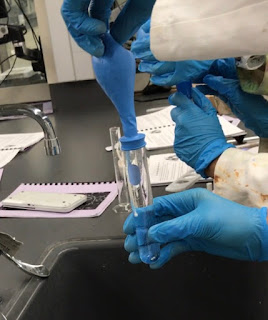Lab 20: Solubility Inquiry Lab
Solubility Inquiry Lab
Introduction:
The purpose of this lab was to identify the name of an unknown solid by dissolving it in different temperatures of water or dissolving different amounts of the solid. While doing this, we used a solubility curve graph of the three possible solutes which allowed us to determine what specific temperatures or amount of solute to test. Some important terms for this lab include solubility curve, solute, solvent, and saturated/unsaturated solution. A solubility curve is the graph of the maximum amount of a solute that can be dissolved, in 100 grams of water, at different temperatures. A solute is the substance that is being dissolved in the solvent. A solvent is the substance which is dissolving a solute. An example of a solute and solvent would be dissolving sugar in water where the sugar would be the solute and the water would be the solvent. A saturated solution is when there is the maximum amount of solute dissolved in water. A solution is unsaturated when there more solute can still be dissolved.
Procedure:
Before we began our lab, we obtained a large and small beaker, a thermometer, a hot plate, ice, a balance, a stirring rod, a solubility curve graph, water and an unknown solid. We also decided which method we would use to determine our solid which was to test 5.0 g of the unknown solid placed in 10mL of water at a high temperature of 50°C. This area on the solubility curve graph would mean that if not all of the solid was dissolved in the water, then it must be NaCl. If it did all dissolve, then we would test it again at a lower temperature of 10°C which would allow us to see if it was KNO2 or NaNO3. If it all dissolved, then, using the solubility curve graph, we knew it would be NaNO3 and if not, then it would be KNO3.
First, we measured out 5.0 grams of our unknown solid on our balance which we would use for our first test. Then, we started heating up and excess amount of water using the large beaker and hot plate. While the water was heating up, we used the thermometer to see when it got up to 50°C. When it reached 50°C, we quickly poured 10mL into the small beaker combined with the solid. While doing this, we made sure the water maintained its temperature and stirred, using the stirring rod, the solid until it was all dissolved. Since all of the solid did dissolve, we knew that the solid could not be NaCl. This left us to test it a second time but with different conditions.
For our second test, we once again measured out 5.0 grams of our unknown solid on our balance. This time, however, instead of heating the water, we cooled it by putting ice with the water in the large beaker making sure the temperature got down to 10°C. Using the thermometer, we kept track of the temperature and added ice to cool it more if needed. When the water was cool enough, we poured 10mL of water into the small beaker with the unknown solid. We then stirred, using the stirring rod, the solution until all of the solid was dissolved. In this test, the solid did not all dissolve which meant that it was KNO3.
Data:
Based on these observations and looking at the graph, we can see that if all the solid was dissolved at 50°C, then the solid is not NaCl. We can also tell that it was not NaNO3 because not all of the solid was dissolved at 10°C. Therefore, it must be KNO3.
Conclusion:
Overall, this lab was very successful because we were able to figure out our unknown solid which was KNO3 or Potassium Nitrate. We knew this because we tested two points on the solubility curve with one above KNO3 and one below. This allowed us to eliminate the other two possible solids because their properties for solubility didn't match the observations and data. The biggest challenge during this lab was trying to quickly move the water from one beaker to the other because the temperature drop was pretty quick and if it changed, we would have had incorrect data. Something we learned from looking at the solubility curve graph was that with solids, as the temperature increases, so will the solubility.





Mesmerized article written on this blog with other relevant information. It is straight to the point that how we can improve our skills as well as how we can be represented to a new stream of professionalism. Heavy metal testing laboratories
ReplyDeleteMetal Testing Laboratories provide critical services for ensuring the quality, strength, and safety of metal materials used across various industries. From aerospace to construction, these labs use advanced techniques like spectroscopy, hardness testing, and corrosion analysis to evaluate metal properties and compliance with standards. Whether you're manufacturing components or verifying raw materials, reliable metal testing laboratories help prevent failures, reduce costs, and maintain product integrity.
ReplyDelete